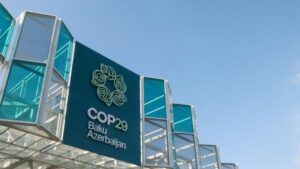Physical Address
23,24,25 & 26, 2nd Floor, Software Technology Park India, Opp: Garware Stadium,MIDC, Chikalthana, Aurangabad, Maharashtra – 431001 India
Physical Address
23,24,25 & 26, 2nd Floor, Software Technology Park India, Opp: Garware Stadium,MIDC, Chikalthana, Aurangabad, Maharashtra – 431001 India

At the COP29-IEA High-Level Energy Transition Dialogues, which began on November 11, 2024, in Baku, Azerbaijan, global leaders and energy experts came together to tackle the urgent challenge of climate change and to advance the global shift toward sustainable energy. Organised in partnership with the United Nations Framework Convention on Climate Change (UNFCCC), the International Energy Agency (IEA) issued a “Call to Action,” urging countries to triple renewable energy capacity, double energy efficiency by 2030, and increase clean energy investments, particularly in developing nations.
Pivotal Targets for 2030: Renewable Energy, Efficiency, and Investment
The COP29 Dialogues established three key focus areas for climate action by 2030:
These ambitious targets demonstrate the global transformation needed across energy sectors to address climate change and support sustainable development.
Key Initiatives: Energy Storage, Grids, and Hydrogen as Strategic Priorities
To advance these targets, COP29 introduced several strategic initiatives:
These initiatives are designed to improve the availability and reliability of renewable energy, setting up regions worldwide for more sustainable energy access.
Addressing Equity and Inclusivity in the Energy Transition
A central theme at COP29 was ensuring that the global shift to clean energy is equitable and inclusive. Many developing nations need more resources and infrastructure to participate fully in the energy transition. COP29 highlighted the need for financial mechanisms to address these disparities, such as the proposed Climate Finance Fund, which aims to mobilise public and private investments in clean energy projects within low-income nations.
The Role of International Collaboration
The COP29 goals depend heavily on international cooperation. Developed nations are encouraged to support developing countries with technology sharing, investment, and capacity building. The IEA underscored that collaborative frameworks will be essential for maintaining progress, allowing countries to share knowledge, monitor collective progress, and address emerging challenges together.
The COP29-IEA Dialogues have set an ambitious yet necessary path forward for the global energy transition, aiming to address the climate crisis through collective commitment, targeted investments, and innovative technologies. These dialogues serve as a wake-up call, signalling that while the journey to net-zero emissions by 2050 is challenging, it is achievable through coordinated global action.
https://www.worldbank.org/en/news/feature/2023/hydrogen-net-zero
Banner image:
Photo by Matthew TenBruggencate on Unsplash
Comments are closed.
I was very pleased to find this web-site.I wanted to thanks for your time for this wonderful read!! I definitely enjoying every little bit of it and I have you bookmarked to check out new stuff you blog post.
You must take part in a contest for among the finest blogs on the web. I’ll suggest this site!
I’ve learn several excellent stuff here. Certainly price bookmarking for revisiting. I surprise how so much effort you place to make this sort of wonderful informative site.
I like this web site so much, saved to my bookmarks. “I don’t care what is written about me so long as it isn’t true.” by Dorothy Parker.
Hi, Neat post. There is a problem with your website in internet explorer, would test this… IE still is the market leader and a large portion of people will miss your excellent writing due to this problem.
After all, what a great site and informative posts, I will upload inbound link – bookmark this web site? Regards, Reader.